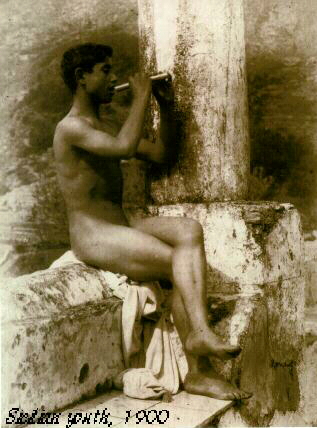
Wilhelm von Gloedens Arcady
Remarks on an obsessed career
Today, anyone who visits the Sicilian tourist
resort of Taormina and picks through the stands of the
"cartolerias", the local postcard merchants and
souvenir traders - for instance stopping by the venerable firm of
the Malambri Brothers - may come across some sepia-toned
postcards depicting Mount Etna rising in the background and
youths posed along terraces or leafy galleries. Occasionally the
boys are wearing Greek togas; more frequently, however, they
appear in God's or (more in keeping with the setting) the gods'
splendour. Turning the cards over, one discovers the name of the
photographer, "Wilhelm von Gloeden".

Who was the man who left such an enduring mark on Taormina, the man who bequeathed his prodigious photographic estate to Pancrazio Bucini (his last model who only passed away in 1977 at the age of eighty-seven), the man who made his entry into the history of photography as the master of the male nude?
Wilhelm von Gloeden is a legendary figure, and there are ample grounds for the legends that have sprung up around his name. The life of this Prussian baron, who was born in 1856 in East Prussia and who died in Taormina in 1931, reads like a fairytale dating from the late Victorian or Edwardian periods. Von Gloeden, a young Prussian country squire, left his homeland for Italy to regain his physical (he suffered from a disabling lung condition) and mental health (the psychological distress he experienced as a pederast unable to indulge his erotic fantasies). After arriving in Taormina, which at the close of the nineteenth century was a small, impoverished Sicilian town unknown to tourists, not only did health and psyche improve, but von Gloeden was able to embark upon his artistic career.
Wilhelm von Pluschow, a distant relative living in Naples, inspired von Gloeden to dedicate himself to the craft of his newly discovered photographic hobby. Using local boys as models, von Gloeden endeavoured in his "tableaux vivants" to achieve a vision of Arcady. The story of the baron's life became the subject of a biography by Roger Peyrefitte, the French sensationalist author. The acceptance of Wilhelm von Gloeden's libertine photography during the prudish Victorian era, an age when, apart from medical or ethnological depictions, any graphic rendering of the sexual organs was censured, is a phenomenon which invites investigation.
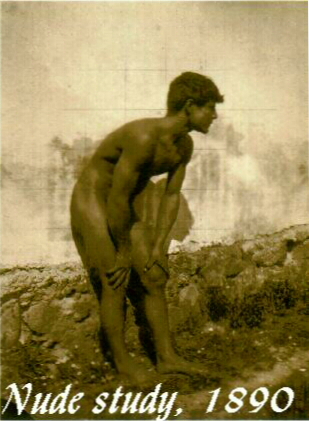 According to Charles Leslie, one of von Gloeden's
earliest serious biographers, the baron was "one of those
rare men of the nineteenth century who refused to bargain away
his innernature, consent to its annihilation, in order that he
might be allowed to assume his place in the so-called civilised
Western world, one which officially condemned him for what he
was." By Leslie's account von Gloeden was a man who treated
everything as subordinate to the vital task of self-realisation.
For this author, influenced by the stonewall movement and the
general awakening of consciousness among homosexuals during our
century's seventies, von Gloeden symbolised the act of
liberation, posed a paradigm example of the artist and his
self-realisation. Von Gloeden, however, is an important figure
for two further reasons: his place in the history of photography,
and his contribution to the local heritage of Taormina, his
adopted home. Especially at the beginning of his residency, while
he was still a man of independent means, von Gloeden was a
generous community benefactor, helping the small Sicilian town to
eventually become one of the fin de si?cle's most
prestigious watering holes. By the turn of the century, poets and
actors, painters and famous society figures flocked to Taormina,
making it a must on their grand Italian tours. After touring the
city's charming Ancient Greek theatre, the travellers would pay a
visit to von Gloeden at his studio, purchasing his pagan
"Illustrations of Theocritus and Homer" - as von
Gloeden called his photographs - images which were mounted in
travel albums alongside the architectural studies of Fratelli
Alinari of Florence, and the Neapolitan folk portraits of Giorgio
Sommer, a Frankfurt-born photographer living and working in
Naples. Von Gloeden's visitors' book, since lost, could boast the
signatures of Oscar Wilde, Gabriele d'Annunzio, Eleonora Duse,
the King of Siam and King Edward VII, as well as those of such
well-known bankers and industrialists as Morgan, St?nnes, Krupp,
Vanderbilt and Rothschild. In 1911, von Gloeden was awarded a
medal in recognition of his valuable assistance in helping
Taormina become a favourite tourist destination.
According to Charles Leslie, one of von Gloeden's
earliest serious biographers, the baron was "one of those
rare men of the nineteenth century who refused to bargain away
his innernature, consent to its annihilation, in order that he
might be allowed to assume his place in the so-called civilised
Western world, one which officially condemned him for what he
was." By Leslie's account von Gloeden was a man who treated
everything as subordinate to the vital task of self-realisation.
For this author, influenced by the stonewall movement and the
general awakening of consciousness among homosexuals during our
century's seventies, von Gloeden symbolised the act of
liberation, posed a paradigm example of the artist and his
self-realisation. Von Gloeden, however, is an important figure
for two further reasons: his place in the history of photography,
and his contribution to the local heritage of Taormina, his
adopted home. Especially at the beginning of his residency, while
he was still a man of independent means, von Gloeden was a
generous community benefactor, helping the small Sicilian town to
eventually become one of the fin de si?cle's most
prestigious watering holes. By the turn of the century, poets and
actors, painters and famous society figures flocked to Taormina,
making it a must on their grand Italian tours. After touring the
city's charming Ancient Greek theatre, the travellers would pay a
visit to von Gloeden at his studio, purchasing his pagan
"Illustrations of Theocritus and Homer" - as von
Gloeden called his photographs - images which were mounted in
travel albums alongside the architectural studies of Fratelli
Alinari of Florence, and the Neapolitan folk portraits of Giorgio
Sommer, a Frankfurt-born photographer living and working in
Naples. Von Gloeden's visitors' book, since lost, could boast the
signatures of Oscar Wilde, Gabriele d'Annunzio, Eleonora Duse,
the King of Siam and King Edward VII, as well as those of such
well-known bankers and industrialists as Morgan, St?nnes, Krupp,
Vanderbilt and Rothschild. In 1911, von Gloeden was awarded a
medal in recognition of his valuable assistance in helping
Taormina become a favourite tourist destination.
In his work, von Gloeden presented a vision of
Taormina's past as a golden age brimming with Greek, Roman, Arab
and 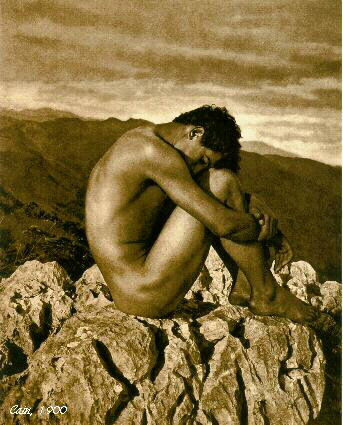 Norman
influences. Like the island of Capri, Taormina became a favourite
haunt of affluent homosexual society. Such customers for von
Gloeden's albumen prints were astonished by their realism a
quality which suffered when - as in the paintings of Hans von
Mar?es - any attempt was made at idealisation. They were apprised
of the photographs' erotic possibilities, whereas educated
mainstream tourists were referred to the sexually neutral
Arcadian costumes and implements.
Norman
influences. Like the island of Capri, Taormina became a favourite
haunt of affluent homosexual society. Such customers for von
Gloeden's albumen prints were astonished by their realism a
quality which suffered when - as in the paintings of Hans von
Mar?es - any attempt was made at idealisation. They were apprised
of the photographs' erotic possibilities, whereas educated
mainstream tourists were referred to the sexually neutral
Arcadian costumes and implements.
What makes von Gloeden's work so fascinating to us today was his ambition to substitute his own personal cosmos for the realities of his age, a design he carried out to the point of insinuating himself, wearing costume apparel, into the midst of his oeuvre. Taormina furnished him with the possibility of constructing a playful, aesthetic counter-world, one which he (and here lies the work's authenticity) never dismissed as solely an artistic fantasy. What was important for him was the aesthetic integrity of his transformations. If one compares his oeuvre with the work of his contemporaries von Pluschow and Vincenzo Galdi, it becomes apparent that von Gloeden not only developed his own narrative style, but also cultivated a different working relationship with his models. Occasionally, photographs of von Pluschow have been attributed to von Gloeden, a confusion that arises because von Pluschow apparently sold von Gloeden's work. Another ground for muddled accreditations has been documented in collections published by such authors as Jean Claude Lemagny and Jack Woody: from time to time, the fragile albumen coating had so deteriorated that the originator's mark had become effaced. In such cases it is impossible to accredit the images authoritatively. However, those nude studies in which the secondary sexual traits have been accentuated stem in all likelihood from Galdi, a photographer with an inclination towards pornographic scenes.
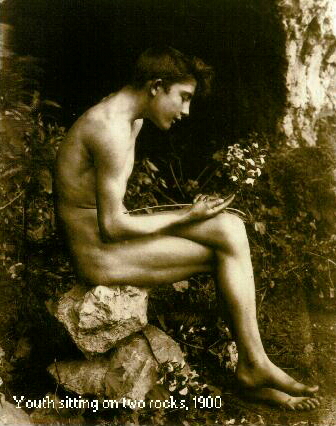 Photography
offered von Gloeden the possibility of transforming his
surroundings by applying the Pygmalion effect in reverse. He
endeavoured to blend the antique and modem worlds, sought to
create a timeless theatre of desirous fantasy. This amalgamation
is clearly evident in one particular study of a youth who had
regularly modelled for von Gloeden over a period of years: in
complementary pose he shares the frame with a popular Greek
statue. Ulrich Pohlmann, who has written the best von Gloeden
monograph published to date, traces von Gloeden's development
from amateur to professional photographer with reference to the
progression of his "living pictures". Pohlmann often
deduces the chronology of von Gloeden's images by light of the
artist's evolving iconography. The baron's living pictures were
carefully composed photographic re-creations of actual scenes.
During the last quarter of the nineteenth century it was quite
common to photograph re-enactments of historic events, or compose
portraits of folkloric customs and trades. Von Gloeden, too,
worked in this photographic genre, producing a lengthy series of
pictorial studies of fishermen and couples dressed in traditional
attire. Also, while touring through Tunisia, he photographed its
inhabitants dressed in native garb, and exposed a number of
plates investigating their physiognomies. But quite aside from
his topographic views of Taormina, or his documentary photographs
- for instance his scenes of Messina in the wake of an earthquake
- von Gloeden's fountainhead theme was his living portraits, his
photographs of the boys of Taormina, youths whom he considered to
be the "representatives of an archaic, classless
society".
Photography
offered von Gloeden the possibility of transforming his
surroundings by applying the Pygmalion effect in reverse. He
endeavoured to blend the antique and modem worlds, sought to
create a timeless theatre of desirous fantasy. This amalgamation
is clearly evident in one particular study of a youth who had
regularly modelled for von Gloeden over a period of years: in
complementary pose he shares the frame with a popular Greek
statue. Ulrich Pohlmann, who has written the best von Gloeden
monograph published to date, traces von Gloeden's development
from amateur to professional photographer with reference to the
progression of his "living pictures". Pohlmann often
deduces the chronology of von Gloeden's images by light of the
artist's evolving iconography. The baron's living pictures were
carefully composed photographic re-creations of actual scenes.
During the last quarter of the nineteenth century it was quite
common to photograph re-enactments of historic events, or compose
portraits of folkloric customs and trades. Von Gloeden, too,
worked in this photographic genre, producing a lengthy series of
pictorial studies of fishermen and couples dressed in traditional
attire. Also, while touring through Tunisia, he photographed its
inhabitants dressed in native garb, and exposed a number of
plates investigating their physiognomies. But quite aside from
his topographic views of Taormina, or his documentary photographs
- for instance his scenes of Messina in the wake of an earthquake
- von Gloeden's fountainhead theme was his living portraits, his
photographs of the boys of Taormina, youths whom he considered to
be the "representatives of an archaic, classless
society".
Wilhelm von Gloeden is important to the history
of photography as an innovator of the nude image - principally of
the male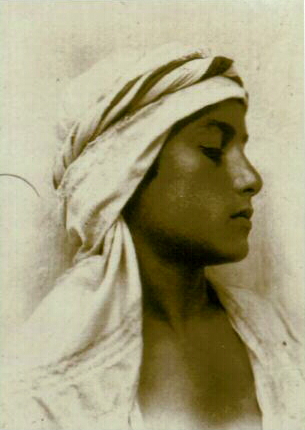 nude. Von Gloeden was a
pioneer, one of the first to compose his nude studies outside the
studio. Nineteenth century conventions demanded that a fig leaf
be placed over the genitals, or that the retoucher's dark-room
art strategically blur the anatomy. Von Gloeden dispensed with
such strictures, his large format plate camera faithfully
reproducing each and every detail of the physique. The baron was
chiefly a pure photographer, his point-of-view blunt and
straightforward. Although he occasionally attempted to idealise
cosmetically the physiques of his models, they always remained
peasant youths. Von Gloeden's portrait settings were balustrades
with splendid views, or, festooned with antique amphorae, its
walls ornamented with an intricate palm design, the inner
courtyard of his own residence. The wildly romantic outlying
mountains also provided choice photographic settings. Together
with his models, von Gloeden would venture to lonesome sites
where he could unhurriedly compose his photographs, many of which
called for protracted shutter exposures.
nude. Von Gloeden was a
pioneer, one of the first to compose his nude studies outside the
studio. Nineteenth century conventions demanded that a fig leaf
be placed over the genitals, or that the retoucher's dark-room
art strategically blur the anatomy. Von Gloeden dispensed with
such strictures, his large format plate camera faithfully
reproducing each and every detail of the physique. The baron was
chiefly a pure photographer, his point-of-view blunt and
straightforward. Although he occasionally attempted to idealise
cosmetically the physiques of his models, they always remained
peasant youths. Von Gloeden's portrait settings were balustrades
with splendid views, or, festooned with antique amphorae, its
walls ornamented with an intricate palm design, the inner
courtyard of his own residence. The wildly romantic outlying
mountains also provided choice photographic settings. Together
with his models, von Gloeden would venture to lonesome sites
where he could unhurriedly compose his photographs, many of which
called for protracted shutter exposures.
At the close of the nineteenth century, von Gloeden's work found swift recognition within the world of photography, his images appearing at important international exhibitions. During 1893 his photographs were published in such trend-setting periodicals as "The Studio" and Velhagen & Klasing's "Kunst f?r Alle" (Art for everyone). In 1898 von Gloeden became a corresponding member of Berlin's "Freie Photographische Vereinigung" (Free Photographic Society).
Von Gloeden's oeuvre, which chiefly took shape between 1890 and 1914, not only intimated his personal homoerotic wishes and projections, but also manifested some typical tendencies of the era, tendencies shared by his artist contemporaries. The return to a virgin setting, the romanticising of the pastoral life - von Gloeden considered the local peasants to be of "noble simplicity and quiet magnitude" - expressed the era's general disaffection with civilised life and a yearning for the bucolic past. Uncensored nude photography was one gesture of the struggle against the nineteenth century dogmatism which vilified the body.
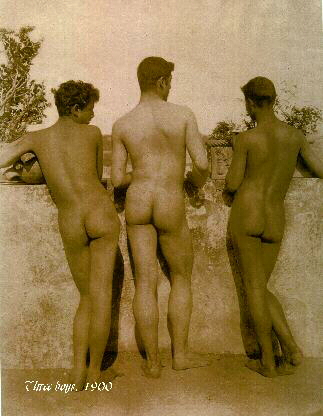 Two factors appear astonishing to us today: how was
it possible that Victorian censors allowed the publication of
nude images so unrepentantly realistic and how did von Gloeden
succeed in convincing local boys to pose for him without either
their families or the Church intervening? Von Gloeden's
photographs are, as we have already noted, neither extravagantly
provocative nor blatantly pornographic - in point of fact, they
quite usually exclude an aura of innocence.
Two factors appear astonishing to us today: how was
it possible that Victorian censors allowed the publication of
nude images so unrepentantly realistic and how did von Gloeden
succeed in convincing local boys to pose for him without either
their families or the Church intervening? Von Gloeden's
photographs are, as we have already noted, neither extravagantly
provocative nor blatantly pornographic - in point of fact, they
quite usually exclude an aura of innocence.
"Although the erotic inspiration and sometimes even the erotic content of these photographs is self-evident", remarks Gert Schiff, "the Victorian public and censors, in a consummate act of self-deception, succeeded in viewing these images as ethnological studies or lyrical evocations of antiquity". Von Gloeden's importance to the history of nude photography arises from his utter dismissal of the genre's taboo, the confident manner in which he manipulates his ephebic, androgynous models, and the sheer magnitude of his output. With the exception of the platinum prints of the Boston philanthropist Fred Holland Day, a contemporary of von Gloeden's who filled his ouvre with analogous motifs (likewise legitimating the nudity of his young models as an exigency of pagan theme), von Gloeden has no peer with respect to both quantitative and qualitative achievement until the arrival of Robert Mapplethorpe during the seventies and eighties of our century.
Gratuitous sexual and pornographic images are
absent from von Gloeden's work. The strong formal elements of his
images remain faithful to the classical rules of composition
which prevailed during the eighteenth and nineteenth centuries;
so too, 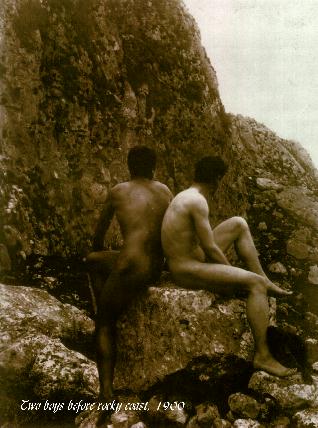 his preference for
the androgynous male nude. Fully evident is a homosexual
preoccupation with such libidinally charged areas of the anatomy
as the penis and buttocks; among nineteenth century work evincing
homosexual contents von Gloeden's images stand quite alone. He
predominantly works with two models, their body language
demonstrative of affection, devotion, Greek attachment. Yet
beyond this category there are also a number of portraits of
individuals in which the sexual connotations, though coded, are
far more blatant.
his preference for
the androgynous male nude. Fully evident is a homosexual
preoccupation with such libidinally charged areas of the anatomy
as the penis and buttocks; among nineteenth century work evincing
homosexual contents von Gloeden's images stand quite alone. He
predominantly works with two models, their body language
demonstrative of affection, devotion, Greek attachment. Yet
beyond this category there are also a number of portraits of
individuals in which the sexual connotations, though coded, are
far more blatant.
How did von Gloeden persuade the local boys to pose for him? Aside from the fact that their activity was remunerated, one must bear in mind that von Gloeden, a man of charisma, arrived in the community as a generous benefactor. In its "indigenous souls" he believed himself to have discovered the direct descendants of the ancient Greeks, a lineage which, though reduced to rags, retained its nobility. One must also bear in mind that, throughout the Christian Mediterranean, homosexuality was tacitly tolerated as a passing phase in a young man's life. "This could quite well be a result", Gert Schiff points out, "of the age-old Graeco-Roman tradition. But perhaps a more logical solution lies in the regional custom of keeping the two sexes separated until marriage, and thus in the wisdom of the church - to be magnanimous in all peripheral questions, yet utterly implacable with regard to the preservation of its own political power."
In one category of images, von Gloeden works with groups of youths whom he positions across the scene in various attitudes, some appearing at leisure, some kneeling, others standing or lying down. Such photographs not only evince an overall mood of hannony, but were also used as "acad?mies", or figure studies by artists. The youths in such photos appear unrelated to one another, disconnected. Other photographs used as figure studies feature models of various ages, their bodies established in ambiguous relationships. Such photos regularly provide disparate anatomical perspectives (for instance, frontal and rear) of two models standing in opposition.
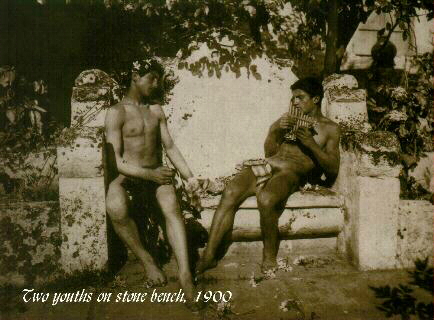 Fauns, figures of
Pan, shepherds and Greek ephebic figures were perfect roles for
the boys of Taormina, these Southern European adolescents who, at
the century's turn, endowed with such healthy exhibitionistic
qualities, took great narcissistic pleasure in their physiques.
Many were natural actors, a trait which helped them through the
lengthy photo sessions. Gloeden was a contemporary of
historicism. In his work, he insouciantly mixed prop accessories
associated with a wide variety of historical epochs. For the
French philosopher Roland Barthes, this clash of historical
vernaculars was a disturbing stylistic flaw. The boys are not
endowed with classically proportioned physiques; rather, their
bodies reveal their situations as hardworking peasant youths. But
today, this is exactly the artistic quirk which we find so
compelling: the idealised imagery of an historic paganism is
winnowed from these images by puberty's fey realism - each youth
has his own face, his own penis. The awkwardness of these
adolescent models posing upon their turn-of-the-century stage is
what appeals to the modern viewer's imagination and purges these
images of any pornographic content. Roland Barthes is quite
correct in observing that von Gloeden has taken "the antique
codex, hyperbolized it, applied it in inspissate layer (ephebi,
shepherds, ivy, palm branches, olive trees, grape vines, togas,
columns, stone slabs), but, (the first distortion) he
mixes the antique symbols, lumps together the Greek vegetation
cult, Roman figurine sculptures, and the 'classical nude' which
stems from the Ecole des Beaux Arts."'
Fauns, figures of
Pan, shepherds and Greek ephebic figures were perfect roles for
the boys of Taormina, these Southern European adolescents who, at
the century's turn, endowed with such healthy exhibitionistic
qualities, took great narcissistic pleasure in their physiques.
Many were natural actors, a trait which helped them through the
lengthy photo sessions. Gloeden was a contemporary of
historicism. In his work, he insouciantly mixed prop accessories
associated with a wide variety of historical epochs. For the
French philosopher Roland Barthes, this clash of historical
vernaculars was a disturbing stylistic flaw. The boys are not
endowed with classically proportioned physiques; rather, their
bodies reveal their situations as hardworking peasant youths. But
today, this is exactly the artistic quirk which we find so
compelling: the idealised imagery of an historic paganism is
winnowed from these images by puberty's fey realism - each youth
has his own face, his own penis. The awkwardness of these
adolescent models posing upon their turn-of-the-century stage is
what appeals to the modern viewer's imagination and purges these
images of any pornographic content. Roland Barthes is quite
correct in observing that von Gloeden has taken "the antique
codex, hyperbolized it, applied it in inspissate layer (ephebi,
shepherds, ivy, palm branches, olive trees, grape vines, togas,
columns, stone slabs), but, (the first distortion) he
mixes the antique symbols, lumps together the Greek vegetation
cult, Roman figurine sculptures, and the 'classical nude' which
stems from the Ecole des Beaux Arts."'
The boys knew no shame. At times with
enthusiasm, at other times, worn out by the long sessions, with
weary boredom, 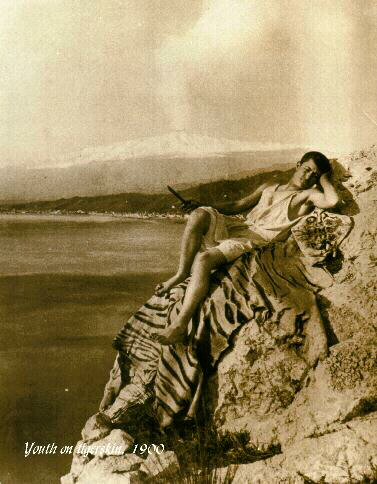 they attempted to
follow the demands of their director - although they often
possessed no real insight into his purposes. However, another
portrait category exists in which the boys articulate no
artificial sentiment, but instead exclude the expectancy or
dreaminess peculiar to adolescence. These portraits, the most
genuine, are also the most successful.
they attempted to
follow the demands of their director - although they often
possessed no real insight into his purposes. However, another
portrait category exists in which the boys articulate no
artificial sentiment, but instead exclude the expectancy or
dreaminess peculiar to adolescence. These portraits, the most
genuine, are also the most successful.
Nude photography during the nineteenth century possessed two pre-eminent purposes: firstly, figure studies aided artists in the absence of live models; and secondly, sold surreptitiously, such images provided a pornographic stimulus. Von Gloeden's work did not always gain large audiences or find its way to exhibitions. Only select motifs were eligible to appear in Velhagen's periodical "Kunst f?r Alle", or were published alongside articles taking Sicily as their theme. Some photographs were accepted by periodicals which began to appear at the turn of the century, catering to the aesthetic tastes and psychological self-image of a male homosexual readership. Such periodicals, sold solely by subscription, naturally eluded a more general audience.
In 1893 "Kunst f?r Alle" published one of von Gloeden's photographs together with a caption remarking that the image depicted "naked natives of the Island of Sicily". The caption's ethnological flavouring was meant to excuse the image's overt nudity.
Von Gloeden's iconography of poses and settings emerges from the venerable classicist tradition. The most famous of such examples is Cain, von Gloeden's version of the painting Solitude by Hyppolyte Flaudrin. We know that many of von Gloeden's contemporaries collected his photographs. Works by such artists as Frederic Leighton, Alma Tademas and Maxfield Parish evidence their acquaintance with Gloeden's oeuvre. One particularly handsome example can be found in the study collection of Berlin's Hochschule der Kunste. Here, the pencilled grid applied to von Gloeden's albumen print is used to give impulse to other artistic projects. Von Gloeden remains an influence in contemporary art. Joseph Beuys, intrigued by the utopian themes, added his own designs to the baron's motifs. Also, artists ranging from Andy Warhol to Michael Buthe have used von Gloeden's erotically inspiring photographs in their work, creating their own interpretations.
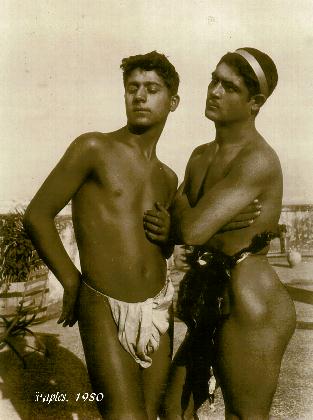 Deprived of his family income, von Gloeden, the
aristocratic amateur, was obliged to employ his artistic hobby as
a means of livelihood. His photographs, exactly like those
of his distant relative, Wilhelm von Pluschow (who besides
merchandising his own "tableaux vivants", also
worked in Naples as a portrait photographer), could be ordered
from a catalogue of small proofs. Here, among images ranging from
genre studies to views of Taormina, from boys clad scantily to
not at all, von Gloeden's wide thematic range becomes apparent.
Interested parties could order their favourite scenes by number.
Von Gloeden's vivid photographic studies intimated to Europe's
homosexuals the fulfilment of their innermost fantasies. The
excessive strictures of the Wilhelmine epoch were circumvented;
through photos these men could find refuge and satisfaction in
the Arcady of the imagination.
Deprived of his family income, von Gloeden, the
aristocratic amateur, was obliged to employ his artistic hobby as
a means of livelihood. His photographs, exactly like those
of his distant relative, Wilhelm von Pluschow (who besides
merchandising his own "tableaux vivants", also
worked in Naples as a portrait photographer), could be ordered
from a catalogue of small proofs. Here, among images ranging from
genre studies to views of Taormina, from boys clad scantily to
not at all, von Gloeden's wide thematic range becomes apparent.
Interested parties could order their favourite scenes by number.
Von Gloeden's vivid photographic studies intimated to Europe's
homosexuals the fulfilment of their innermost fantasies. The
excessive strictures of the Wilhelmine epoch were circumvented;
through photos these men could find refuge and satisfaction in
the Arcady of the imagination.
The photographs are difficult to date with any certainty. Not until 1897 - a relatively late point in his career - did von Gloeden set about placing his work, in order and stamping the back of the majority of his prints. Unfortunately, his numbering fails to correspond with any chronology. Perhaps the best chronological clues are those provided by the boys von Gloeden worked with over a period of years. In such photographs we can follow the slow passage of adolescence. By and large, once a model had crossed the threshold from adolescence into young adulthood, he was no longer willing to pose for von Gloeden.
Publications springing up around von Gloeden's name have regularly brought to light new material, testifying to the wealth of his erotic motifs. The Italian journalist Pietro Nicolosi estimates von Gloeden's vast oeuvre to have at one point numbered some 7000 glass negatives, a figure by no means inflated.